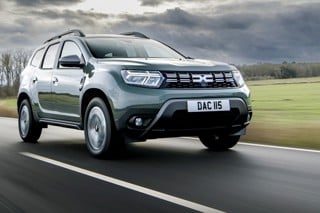By contrast, Alfa Romeo, a brand aiming for premium billing, was always going to struggle to survive for long selling two hatchbacks and a Porsche Cayman-rivalling flagship coupé alone.
Following a 100% increase in the number of mainstream models it will offer in 2017, its dealer partners will be desperate for an uplift in fortunes. There is a sense that the arrival of the Giulia saloon and new Stelvio SUV may have come just in the nick of time.
 Andrew Tracey, recently appointed Alfa Romeo and Jeep country manager, would argue that the brand is under “no pressure to push volume”, but a sense of growing desperation at the Italian marque’s 53 UK retail sites became evident as dealers scored it 3.4 overall (average: 5.6) in the NFDA’s Summer 2017 Dealer Attitude Survey.
Andrew Tracey, recently appointed Alfa Romeo and Jeep country manager, would argue that the brand is under “no pressure to push volume”, but a sense of growing desperation at the Italian marque’s 53 UK retail sites became evident as dealers scored it 3.4 overall (average: 5.6) in the NFDA’s Summer 2017 Dealer Attitude Survey.
As premium brands exert ever more influence on the volume of UK car sales, some could be accused of having too many models on offer, as they look to cover every available niche.
By contrast, Alfa Romeo, a brand aiming for premium billing, was always going to struggle to survive for long selling two hatchbacks and a Porsche Cayman-rivalling flagship coupé alone.
Following a 100% increase in the number of mainstream models it will offer in 2017, its dealer partners will be desperate for an uplift in fortunes. There is a sense that the arrival of the Giulia saloon and new Stelvio SUV may have come just in the nick of time.
 Andrew Tracey, recently appointed Alfa Romeo and Jeep country manager, would argue that the brand is under “no pressure to push volume”, but a sense of growing desperation at the Italian marque’s 53 UK retail sites became evident as dealers scored it 3.4 overall (average: 5.6) in the NFDA’s Summer 2017 Dealer Attitude Survey.
Andrew Tracey, recently appointed Alfa Romeo and Jeep country manager, would argue that the brand is under “no pressure to push volume”, but a sense of growing desperation at the Italian marque’s 53 UK retail sites became evident as dealers scored it 3.4 overall (average: 5.6) in the NFDA’s Summer 2017 Dealer Attitude Survey.
When asked how satisfied they were with their return on investment from the brand, Alfa Romeo dealers pulled no punches, with a damning 1.7 score, well down on the 4.7 average and even the poor 2.9 score recorded in the previous winter survey. It was just below Tracey’s other brand, Jeep, which scored 2.0.
Alfa finished bottom in terms of current profit return too, scoring 2.4 (average: 4.8) to land just below Jeep’s 2.5 score.
Tracey, who has been in post at FCA Group since May, insisted that he had no regrets about joining the brand, even after getting such a rough reception, and has already set about improving relations.
“I’m not unduly disappointed,” he said, speaking to AM at the recent launch of the Stelvio SUV.
“It has been a very tough time for the dealer network for a few years.
“But we are here today at the launch of the car that we have all been waiting for.”
He said Alfa had been operating in a booming SUV market with the Mito, the Giulietta and the 4C, which gave it “a small market opportunity”.
“We needed a more mainstream, volume-viable car. Giulia and Stelvio give us this.
“There is reason for optimism.”
Before FCA, Tracey spent 15 years with Volkswagen Group in Milton Keynes, most recently as head of marketing at Seat UK.
His appointment was made in a series of senior changes at Alfa Romeo, which saw Ashley Andrew, former head of operations at Seat UK, appointed managing director.
Tracey said he was keen to follow Andrew, citing an emotional pull to the Alfa Romeo and Jeep brands.
“I had 15 great years at Volkswagen Group. It was a great schooling ground, but what attracted me here was the brands,” he said.
“To join at a point of transformation for both brands was too good not to take advantage of. It feels like I’m in the right place at the right time and have an
opportunity to be part of something truly different, and truly unique, and get in on the ground floor.”
Tracey met Alfa Romeo’s eight-strong dealer council before the Stelvio launch event and has already organised a series of sub-committees, at which dealers debate and contribute ideas about all aspects of the business.
He believes more open communication and influence can only benefit what appears to have been a failing relationship. “That, and greater profitability,” he said.
Head over heart?
At the launch of the Stelvio, Sacha Barber, Alfa Romeo’s senior exterior designer, showed the assembled press a quote from Orazio Satta Puliga, the renowned former Alfa Romeo head of design.
Puliga, who died in 1974, said: “Alfa Romeo is a particular way of living, of experiencing an automobile”, evoking sensations “more to do with the heart than with the head”.
Dating back to 1946, his comment embodied an emotional side to Alfa Romeo that Barber and Tracey both acknowledge. Tracey said: “Especially in the UK, there is a will both inside and outside the industry for the brand to be successful.”
However, with rivals such as Audi, BMW and Mercedes-Benz appealing very much to the head, via attractive PCP offers that have lured impressive numbers of customers into the premium segment, Alfa now needs more than emotional appeal.
Registrations of 4,881 in 2016 were 3.7% down on 2015’s 5,069 in a market up 2.3%. The slip came in a year when premium brands Audi, BMW and Mercedes-Benz all grew their registrations by 6.4% (to 177,304), 9% (to 182,593) and an impressive 16.9% (to 169,828), respectively.
Nor was 2016 an isolated fall – Alfa has been on the slide since 2011, when it had 11,563 registrations and 0.6% market share.
However, September brought evidence that the Giulia has helped to steady the ship. While all three German brands registered sales down on 2016, Alfa Romeo was up 11.84% at 841 (2016: 752). That takes its year-to date decline to 0.72%, with a total of 4,009 sales (2016: 4,038) and holding 2016’s market share of 0.19%.
The brand may also expect to carry some momentum to the end of the year, following the introduction of the Stelvio.
Tracey said: “Stelvio launched effectively in September. The demos will be registered, fleet cars have been registered and some customer cars.
“Lots of the stock arrives later in the month, so that volume is not Stelvio-oriented, which is good. It means that we have that growth yet to come.”
Tracey said he hopes to see about 2,500 Giulia’s sold in 2017 (Sept YTD: 1,704) and expects the Stelvio to almost match the brand’s current annual registrations.
He believes 4,000 Stelvios could be registered in its first full year.
“It’s got the potential to really take off in terms of demand. We do have open production so we can meet that demand, but we won’t push. We don’t need to,” said Tracey.
Tracey was unable to confirm when Alfa Romeo may introduce an EV or plug-in hybrid.
He said EVs were undergoing testing in the US and would become part of the range by 2020, but expected more detail to be made clear when Sergio Marchionne, FCA Group’s chief executive, set out his five-year plan in Q1 of next year.
Managing the brand
Tracey said he wants a new dealer corporate identity (CI), which brings together Alfa Romeo and Jeep at most UK sites, completed “as soon as possible”. However, from its introduction in 2015, it is expected to be 36% complete by the end of 2017.
The new CI brought some of the harshest scores in Alfa’s NFDA results.
When asked about the required level of capital investment Alfa Romeo demands from its retailers, respondents scored the brand a bottom-placed 1.7 out of 10 (average: 5.1) – down on the winter survey’s 4.2.
Currently, just 22 of the brand’s 53 sites are coupled to Jeep.
“The two brands complement each other and it gives retailers a better foundation for profitability,” insisted Tracey.
“The CI brings the experience from a customer perspective in line with the kind of product we now have. People expect a certain standard of environment and service when they invest a larger amount in a car.
“Think of 2016 and the average cost of an Alfa Romeo, which would be Mito and Giulietta [compared with] the start of next year – there will be a much heavier weight towards Giulia and Stelvio. The average price will have doubled, which is great from a dealer profitability point of view, but that comes with a different customer expectation in all respects.
“In terms of used cars, another benefit to the dealer is that the part-exchanges that are coming in as people buy Stelvio and Giulia will be more premium and will feed that whole value chain of profitability.”
The make-up of the Alfa Romeo network is now 27 owner-operators and one PLC, Cambria Automobiles. Top 10 AM100 groups Vertu Motors and Lookers withdrew from the network in 2017.
Tracey does not expect any wholesale changes in representation, but he is keen to expand the size of the network, saying that the 53 sites currently operating leave “big geographical gaps to fill”.
He said he would like to see Alfa Romeo represented at closer to 125 locations, but was mindful that this would only be made possible by a growth in registration volumes.
“We need that again, as and when that becomes viable,” he said.
Premium service coupled to accessibility
Alongside its attempts to present a new image via its product and retail partners’ showrooms, Alfa Romeo has been working on delivering a more premium service directly to customers.
“You can have the most beautiful-looking environment and the worst customer experience,” said Tracey. “One doesn’t necessarily lead into the other.”
The FCA Group has launched a training course called Path to Premium, which it runs at its FCA Academy in Slough. Apprentices receive their training via the University of Slough and some of FCA’s own staff and retailers’ sales teams have now passed through.
Tracey believes the results are already being seen, citing Jeep’s placing in the top 10 of the What Car? Driver Power Survey 2017.
He said: “We have now brought in a customer experience director. They will lead the digital function and management function for us, liaising directly with the network.”
Part of Alfa Romeo’s push towards premium is an attempt to justify the £4.3 billion investment said to be planned for the brand by 2020 – most of it for developing the all-new, rear-wheel-drive platform the Giulia and Stelvio models sit on.
Residual value forecasts (three years/60,000 miles) for the Stelvio range from 40% to 44% of list price, according to Cap HPI’s September 2017 Gold Book.
These RVs “position the Stelvio among the slowest-depreciating models in its class”, according to Alfa Romeo.
In a television advert shown in an early viewing at the launch event in Northern Ireland, the Stelvio is hailed as “a challenge to the established rivals”.
Tracey said he is keen to ensure the brand remains accessible as it makes the move upmarket, with the introduction of a saloon starting at £29,875 and an SUV starting from £33,990.
He said: “We have no issue selling accessibility. I don’t think the ability to communicate price in marketing material compromises that premium feel anymore. The market has changed.”
However, while its German premium rivals have benefitted from a shift into the mainstream driven by the affordability of PCP offers made possible by low interest rates, Alfa Romeo’s finance offers seem wide of the mark.
Notably, FCA Automotive Services has been unable to set a representative PCP or PCH below £300 per month for the Giulia – with its 6.9% APR, 48-month offers – a psychological barrier exploited by the Audi A4, BMW 3 Series and Mercedes-Benz’s C-Class at dramatically lower interest rates.
Similarly, the Stelvio’s promoted PCP offer at launch was a 6.9% APR agreement with £439 monthly repayments, making it look expensive next to the competition’s 1.9% and 2.9% APR agreements.
Tracey is confident that the product has the appeal to drive the Alfa Romeo brand forward, however.
Seeking to draw comparisons with the successful introduction of the Renegade SUV to his other brand, Jeep, back in 2014, Tracey said the effects of new product can be “transformative”.
Jeep’s market share of 0.1% in 2013 rose to 0.52% on the back of Renegade sales.
“That in itself was transformational,” said Tracey, who believes the Stelvio and Giulia have the potential to have a similar effect.
“If we do our job right and the network do their job right, Alfa Romeo is in the same place. I can’t think of many brands that will have that scale of change in the next two or three years.”
However, that growth included rapid rises in the volume of Renegades put into Motability and short-term rental, with little benefit to dealers.
Tracey will be hoping that the effects of the Stelvio and Giulia on Alfa Romeo are more sustainable than the short-lived spike generated by the Renegade.
In the nine months to the end of September, Jeep registrations fell 53.3% year-on-year – from 5,492 to 11,762.
Focus on fleet
Sweeping changes to the Alfa Romeo range and corporate identity have been introduced alongside vehicle life-cycle management intended to improve residual values and dealers’ used vehicle stocks.
 Francis Bleasdale, fleet and remarketing director at FCA Group and the recipient of the Most Improved Fleet Manufacturer of the Year award at the annual awards of AM’s sister publication, Fleet News, has overseen a transformation of Alfa Romeo’s remarketing and fleet operations.
Francis Bleasdale, fleet and remarketing director at FCA Group and the recipient of the Most Improved Fleet Manufacturer of the Year award at the annual awards of AM’s sister publication, Fleet News, has overseen a transformation of Alfa Romeo’s remarketing and fleet operations.
Speaking to AM, he said the group relaunched its remarketing activity in September 2016 in anticipation of the new product.
Among the changes is a new Selected For You used vehicle programme for Jeep and Alfa Romeo, which was launched alongside a new online search facility linked to dealer websites.
Efficiencies were also achieved in the delivery of used cars to retailers, by centralising preparation duties.
Bleasdale said: “All the product we generate ourselves goes through and is delivered in a retail-ready condition with a customer promise attached, getting the balance of the warranty and then 12 months attached.
“We have a range of tools for dealers. There is an online locator where they can view stock and purchase directly and they can fund their purchases through the FCA bank.
“From a business perspective, we really are looking towards selling to retail and growing our presence with small business owners and user-choosers and we have spoken to dealers about where opportunity lies.”
Bleasdale introduced a dedicated ‘total cost of ownership’ manager to his team, who liaises with residual value guides including Cap HPI in an attempt to improve RVs.
Tracey said: “A great example is the Giulia. Because of the way it’s been managed, launched and run, there has been no push for volume from [Italy] or from us. The car has performed naturally in the market and we have kept it in the right channels – retail and corporate and corporate leasing – where it has performed well.
“We’ve not gone anywhere near short-term channels and because of the way we have worked with Francis’ team and with CAP, the RV on that car [43-47%] is impressive.
“The Speciale trim is the heartland of the car. Even though we expect to sell 60% across the top two trims, Speciale realistically is the corporate sector’s main car.
“As of September, that has the best RV in the segment, better than Jaguar, BMW or Mercedes-Benz and even Audi.
“We may be a million miles away from them in terms of volumes, but we certainly aren’t in terms of product and our RVs now reflect that.”
Login to continue reading
Or register with AM-online to keep up to date with the latest UK automotive retail industry news and insight.



















Login to comment
Comments
No comments have been made yet.